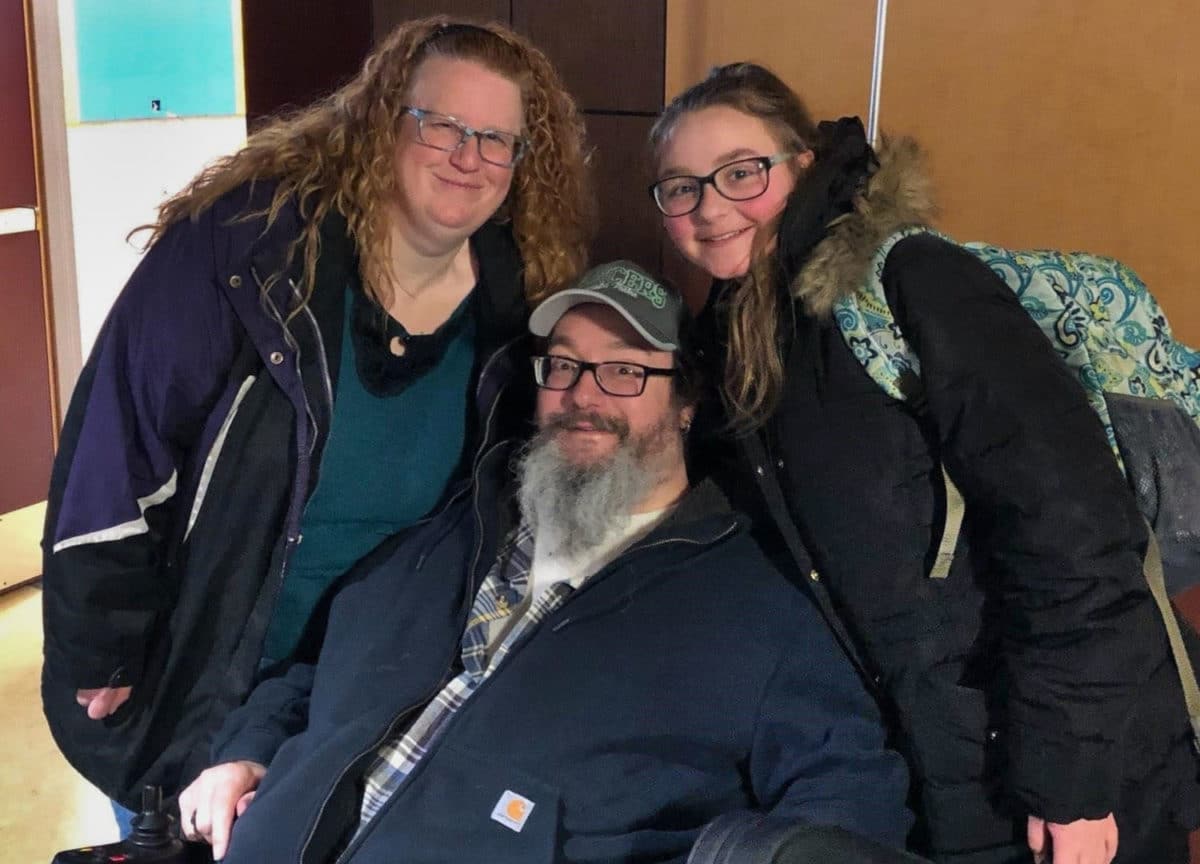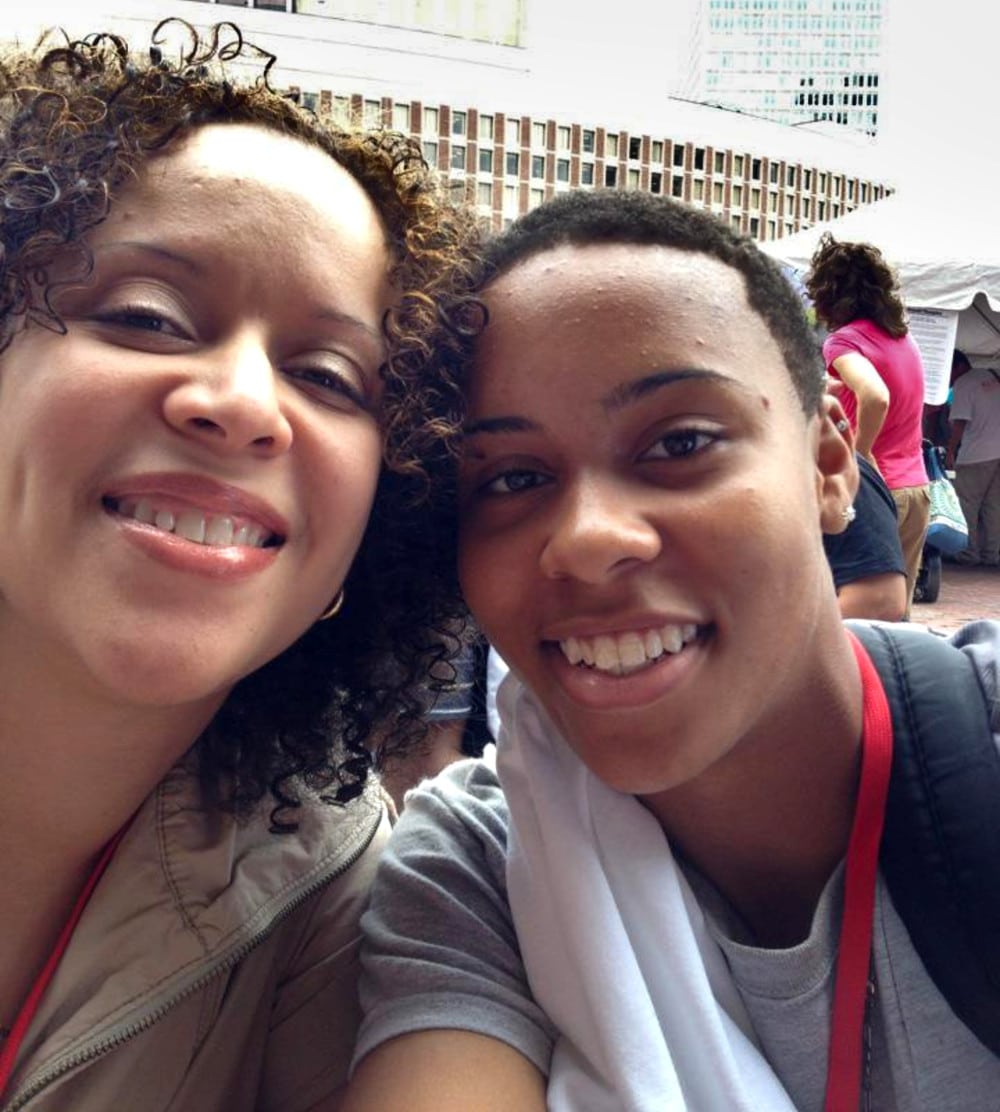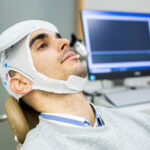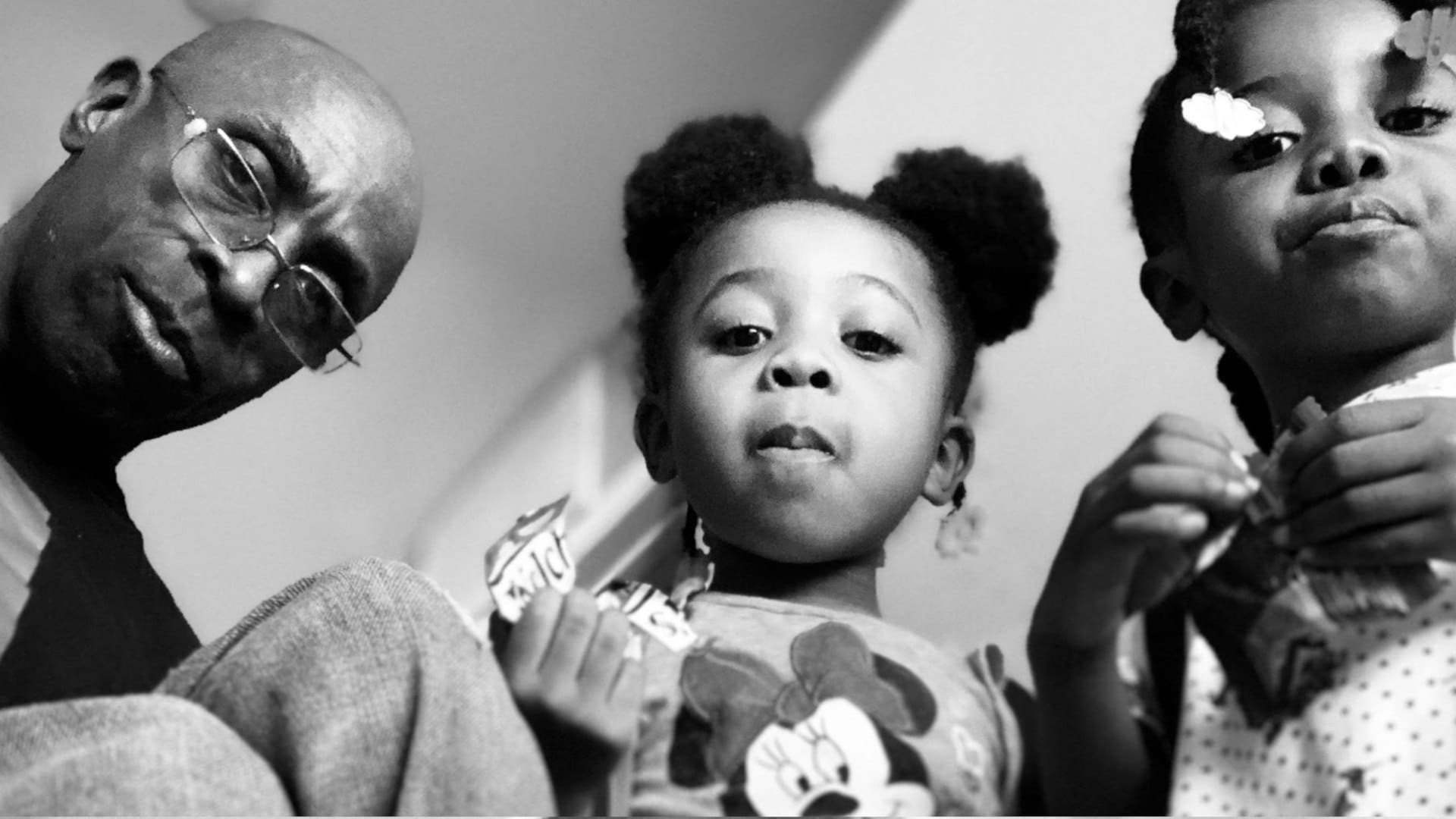For Physically Disabled Parents, Covid’s Trials Are Amplified
In February 2020, Chris Wylie went bowling with his daughter, Hope. At the time, Wylie — who has cerebral palsy and asthma and uses a wheelchair — split custody of Hope with her mother. That evening, the two ate pizza with family and played games at the local event center in Lewiston, New York, near Niagara Falls.
It was the last time Wylie and Hope would see each other in person for a year. As Covid-19 cases rose in New York, Wylie began to speak with friends working in health care. Knowing he was at high risk for complications from Covid-19 because of his disabilities, Wylie stopped leaving the house in early March. During the same month, Wylie and his daughter’s mother decided it would be best for Hope to stay with her mother full time, instead of going back and forth between their houses.

Chris Wylie with his daughter, Hope (right). After the pandemic began, Wylie didn’t see Hope in person for a year.
Visual: Courtesy of Chris Wylie
The separation stretched through the summer and fall, and into 2021. Instead of attending his daughter’s 14th birthday party in early February, he could only FaceTime her.
“Do I risk seeing her in person and risk my life, or am I trying to be around for the long haul to see her finish growing up, to see her get married?” said Wylie. “We know the numbers of people who have died. And that’s really scary.”
Across the United States, parents have dealt with school closures, lack of work, isolation from community support, and other obstacles during the Covid-19 pandemic. And for the millions of parents with disabilities in the U.S., those challenges are often compounded. Some of those parents, especially those with physical disabilities, face an elevated risk of suffering severe complications from Covid-19. Some disabled parents have barely left their homes in more than a year, afraid of what would happen to them or their families if they get Covid-19. Others, like Wylie, have felt unable to safely see their children in person at all.
The pandemic experiences of parents with disabilities have been diverse. And they have, at times, highlighted the fragile support available to many disabled parents.
Those experiences have also sometimes seemed invisible, parents and advocates said, receiving little attention from policymakers and the broader public — part of a long-running pattern of oversight. “I think people don’t really envision or picture people with disabilities as parents,” Wylie said. “But I’m doing the same things as any other parent would do.”
In 2012, there were 4.1 million disabled parents living in the U.S., about 6.2 percent of all parents with children who were under the age of 18, according to a study published by the National Council on Disability. It’s the most recent statistic available. Robyn Powell, one of the study’s authors and a co-investigator with the National Research Center for Parents with Disabilities at Brandeis University, believes there are even more U.S. parents with disabilities today. Precise estimates are difficult to find, she said, due to the lack of data about disabled parents.
While researchers have found links between some disabilities, like Down syndrome, and higher rates of hospitalization or death from Covid-19, research on how the virus indirectly and directly affects people with physical disabilities remains sparse, according to a recent study in Disability and Health Journal. “Studies with the main goal of investigating the impacts on this population should therefore be conducted,” the researchers concluded, “if we want to better respond to their specific and unique needs.”
The scarceness of reliable information has left many disabled parents on high alert. At the same time, the pandemic has removed some of their support structures — which, Powell said, were already lacking before the pandemic. “Disability services are really set up in such a way that they’re only supposed to help the actual person with a disability live this independent life,” Powell said. “And that hasn’t really ever been seen as also, perhaps, helping them in their role as parents.”
Such obstacles and oversights, Powell said, are more pronounced for members of marginalized communities. For example, disabled people of color are reported to child welfare systems at a higher rate, she said, because they are experiencing both racism and ableism.
Therí Pickens, an English professor at Bates College and author of “Black Madness :: Mad Blackness,” an academic study of the relationship between Blackness and disability, said that the Black community may be cautious to identify themselves as disabled because “Blackness in its inception in the U.S. has often been linked with disability as deficiency, so Blackness as disability.”
She also noted that disabled parents, along with Black and Brown communities at-large, haven’t been prioritized for vaccines because of a cultural narrative surrounding the expectation of disability. For “people like us who have a disability but are below the ages of 65 or 70,” she said, “Disability is not expected of us. It is assumed the elderly take precedence because we expect the elderly to be disabled, and that’s a narrative that we understand.”
In interviews with Undark, several disabled parents said they had taken Covid-19 seriously starting early in the pandemic, concerned about the potential health risks and, in some cases, about the pandemic response under then-President Donald Trump.

Disability advocate Heather Watkins (left) said that due to her physical disability, she “always concentrated on more of the emotional bond” with her daughter, which has been helpful during the pandemic.
Visual: Courtesy of Heather Watkins
Heather Watkins, a disability advocate in Boston born with a form of muscular dystrophy that impacts mobility and respiratory muscles, said that when she first heard about the pandemic, she worried it would last for years due to the poor response of the government. “We were seeing denials,” said Watkins, who is the parent of an adult daughter. “That’s why I was like, ‘This is gonna be a wild ride.’”
In March 2020, the World Health Organization warned that “people with disability may be at greater risk of contracting Covid-19” and that they “may be at greater risk of developing more severe cases of Covid-19 if they become infected.” That month, as lockdowns began in parts of the U.S., the National Research Center for Parents with Disabilities hosted an online forum for disabled parents to discuss their experiences of the pandemic. “It’s a scary time for everyone,” one participant reported, “but most nondisabled parents who aren’t high risk don’t have to grapple with the potential that they could very likely die if infected.”
One of those parents at high-risk is Crystal Evans. Evans, a single parent who has a neuromuscular disease, uses a wheelchair, and needs a ventilator to breathe. Before the pandemic began, Evans and her 10-year-old daughter would go for rides on the subway system in Boston, where they live. Her daughter is autistic, and has a special interest in the Massachusetts Bay Transportation Authority. She wanted to visit all the dots on the map. They completed the red, orange, blue, and silver lines and were about halfway through the green when the pandemic stopped them in their tracks.
While she has been able to work from home and her daughter has attended remote school, Evans said it has been harder to receive other accessibility measures she needs to balance safety and childcare during a pandemic. Evans’ health conditions require her to follow a specialized diet, and her kitchen is currently inaccessible due to her wheelchair, making it impossible for her to roll up to the counters and cook there. In the past, she has depended on personal care assistants for help, but since the pandemic began, she said, finding assistants has been difficult, and having people in the house places her family at a higher risk to get Covid-19.
But, during the pandemic, Evans’ insurance company has repeatedly denied her requests for accessibility upgrades, saying instead she needs to continue relying on personal care assistants. “Most of my denials are either around what I need to survive a pandemic as a vent user, just because of Covid, or things that I need for independent living,” she said. “The other factor they don’t see in this, when they’re forcing people to do everything for me: I’m a parent. My daughter needs my attention, too.”
The risks associated with the pandemic have also made it difficult for some parents, like Wylie, to spend time with their kids while managing their high Covid-19 risk. For instance, Keith Jones hasn’t seen his children since January 2020. Jones, who has cerebral palsy, is co-founder of Krip-Hop Nation, working at the intersection of community and public policy through music. Jones has been working on new music in the New Jersey apartment he’s been holed up in during the pandemic. He talks often to his 26-year-old son, 12-year old daughter, and twin 6-year-old daughters, even though he isn’t able to travel to see them. “We do what we can, the best we can,” he said.
Several disabled parents said their life experiences have made certain aspects of the pandemic easier to navigate. “From the disabled parent perspective, I’ve found virtual school so much easier than a brick and mortar school,” said Evans. “And I’m encountering a lot less barriers as a parent with a disability dealing with a virtual school than I did with the regular school system.” Many said they have also benefited from more flexibility around remote work — an accommodation disability advocates have sought for years, with limited success.
Watkins has also found that her distinctive experiences of parenting and disability have helped her adapt to the constraints of pandemic life. She and her daughter have spoken on the phone every day, having conversations about everything from politics to music to global and local events. “We really always had that close bond,” Watkins said. “And I think it’s particularly because I wasn’t that physical parent, the one that could run and jump and be out on some field.” As a result, Watkins said she “always concentrated on more of the emotional bond,” which she said has been helpful during the pandemic.
Even amid the national vaccine rollout, disabled parents have not always found it easy to access shots. Before vaccine eligibility opened up to all people age 16 and older, Centers for Disease Control and Prevention vaccination guidelines only granted priority to a handful of underlying conditions, and it was up to individual states to decide which particular conditions qualified their residents for the vaccine.
In the absence of clear data showing a link between certain conditions and Covid-19 risk, many states did not give people with disabilities high priority. Some advocates have criticized policymakers for doing too little to vaccinate younger disabled people.
Watkins said that vaccine prioritization could have done more to account for the experience of disabled parents — especially those navigating multi-generational homes.
“Conversation always needs to include disabled parents who are sort of sandwiched in between taking care of their children and elderly relatives, or parents who typically live in the home,” she said. The impact this has on families can be exhausting, in particular for communities of color who often take care of each other in multigenerational households, she said. “You’re juggling all these balls, and you end up thinking, ‘How am I going to get the help that I need without falling apart?’ There’s not enough hours in the day, or enough hands.”
Still, more than a year into lockdowns, some parents are finding hope in vaccinations and lower Covid-19 rates. In upstate New York, Wylie and his wife were able to get vaccinated, and his daughter moved back into their house on March 1. He couldn’t be happier. “The whole feel of the house is different,” he said. “And that’s an amazing feeling.”
Izz Scott LaMagdeleine is a freelance journalist and fact checker living in Charleston, South Carolina. They are an inaugural ElectionSOS fellow and have written for The Objective.











Comments are automatically closed one year after article publication. Archived comments are below.
The disabled are often “unseen,” reminders of too real vulnerabilities; we are all meandering through life toward inevitable death, and the disabled are perceived as just a few steps closer to that truth. In my view, that’s a leg up on reality. And reality is…real. In addition to being squeezed between caring for two other generations, the disabled person must care for him- or herself. And that’s not just about moisturizer. Self-care is putting on shoes that may have awkward braces attached to them, zipping zippers, buttoning buttons, brushing teeth with your good hand. While others at home need that parent, she’s looking for her glasses, hoping they are on her nightstand because looking under the bed is not an option; or he has slipped off his chair trying to reach his cellphone. A disabled parent may be the center of family life, its organizer-in-chief, but “just” getting dressed or wiping up spilled coffee can require painstaking strategies. Ironically, as the author points out, some aspects of the pandemic have eased the pressures of daily life for the disabled, taming each new day’s relentless pace. Working at home, shopping online, attending a concert via Zoom, these are absolute blessings for people who cannot walk or lift or stand in line. As the abled return to more active lives, so too will some of the disabled. But the gulf between them will again widen. Will the abled have noticed? Will they remember? And see?